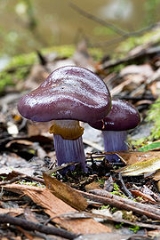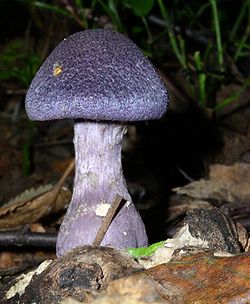
Cortinarius
Encyclopedia

Genus
In biology, a genus is a low-level taxonomic rank used in the biological classification of living and fossil organisms, which is an example of definition by genus and differentia...
of mushroom
Mushroom
A mushroom is the fleshy, spore-bearing fruiting body of a fungus, typically produced above ground on soil or on its food source. The standard for the name "mushroom" is the cultivated white button mushroom, Agaricus bisporus; hence the word "mushroom" is most often applied to those fungi that...
s. It is suspected to be the largest genus of agaric
Agaric
An agaric is a type of fungal fruiting body characterized by the presence of a pileus that is clearly differentiated from the stipe , with lamellae on the underside of the pileus. "Agaric" can also refer to a basidiomycete species characterized by an agaric-type fruiting body...
s, containing over 2000 different species and found worldwide. A common feature among all species in the genus Cortinarius is that young specimens have a cortina (veil) between the cap and the stem, hence the name, meaning curtained. Most of the fibers of the cortina are ephemeral and will leave no trace once gone, except for limited remnants on the stem in some species. All have a rusty brown spore print
Spore print
thumb|300px|right|Making a spore print of the mushroom Volvariella volvacea shown in composite: mushroom cap laid on white and dark paper; cap removed after 24 hours showing pinkish-tan spore print...
. The common name
Common name
A common name of a taxon or organism is a name in general use within a community; it is often contrasted with the scientific name for the same organism...
s cortinar and webcap refer to members of the genus.
Distinguishing features
The veil protects the gillsGill (mushroom)
A lamella, or gill, is a papery hymenophore rib under the cap of some mushroom species, most often but not always agarics. The gills are used by the mushrooms as a means of spore dispersal, and are important for species identification...
in younger specimens and usually disappears leaving little to no trace of itself as the mushroom grows. The spore
Spore
In biology, a spore is a reproductive structure that is adapted for dispersal and surviving for extended periods of time in unfavorable conditions. Spores form part of the life cycles of many bacteria, plants, algae, fungi and some protozoa. According to scientist Dr...
s of a Cortinarius mushroom are rusty brown to brownish red in color. It is usually possible to identify a mushroom as being a member of the genus, but extremely difficult to positively identify the species as many of the species are nearly identical. All mushrooms in this genus form mycorrhiza
Mycorrhiza
A mycorrhiza is a symbiotic association between a fungus and the roots of a vascular plant....
e.
Many mushrooms in the genus—for example Cortinarius sanguineus and other species in section Dermocybe
Dermocybe
The fungi of the Dermocybe group, commonly known as Skin-heads, form a group within the huge genus Cortinarius. They are generally considered to be a subgenus though some authorities consider them to form a genus in their own right....
—are colourful and are often used for dyeing
Mushroom dye
Mushrooms can be used to create color dyes.The shingled hedgehog mushroom and related species contain blue-green pigments, which are used for dyeing wool in Norway. The fruiting body of hydnellum peckii can be used to produce a beige colour when no mordant is used, and shades of blue or green...
.
Toxicity
Several mushrooms in the genus Cortinarius are poisonPoison
In the context of biology, poisons are substances that can cause disturbances to organisms, usually by chemical reaction or other activity on the molecular scale, when a sufficient quantity is absorbed by an organism....
ous, mainly because they cause acute tubulointerstitial nephritis. Some are even lethal
Death
Death is the permanent termination of the biological functions that sustain a living organism. Phenomena which commonly bring about death include old age, predation, malnutrition, disease, and accidents or trauma resulting in terminal injury....
, such as Cortinarius rubellus and Cortinarius orellanus. Therefore, a common rule when it comes to mushrooms from this genus is that none of them should be eaten. However, some species—notably the giant of the genus, Cortinarius praestans
Cortinarius praestans
Cortinarius praestans, also known as the goliath webcap, is a basidiomycete mushroom of the genus Cortinarius. The mushroom has orangish-yellow caps that reach up to in diameter, and thick club-shaped stems up to long...
and the gypsy mushroom (Cortinarius caperatus
Cortinarius caperatus
Cortinarius caperatus, commonly known as the gypsy mushroom, is a highly esteemed edible mushroom of the genus Cortinarius found in northern regions of Europe and North America. It was known as Rozites caperata for many years, before genetic studies revealed it lay within the large genus Cortinarius...
)—are edible and appreciated in several European countries.
The toxin in Cortinarius species, orellanine
Orellanine
Orellanine or Orellanin is a pyridine N-oxide and a crystalline alkaloid that is found naturally in some lifeforms, specifically certain fungi. It is also a mycotoxin. It has been found in at least five species of mushrooms in the Cortinariaceae family....
is easy to detect because it is fluorescent. It has been found in at least 34 Cortinariaceae.
Classification
Recently, molecular studies of members of the genus Rozites, including its most famous member R. caperata have shown them nested within Cortinarius and have been sunk into this genus.Some consider the subgenus Dermocybe to have generic status.
Species
- Cortinarius austrovenetus - also known as Dermocybe austroveneta or Green Skin-head is an Australian fungus typical of the brightly coloured DermocybeDermocybeThe fungi of the Dermocybe group, commonly known as Skin-heads, form a group within the huge genus Cortinarius. They are generally considered to be a subgenus though some authorities consider them to form a genus in their own right....
subgenus. - Cortinarius orellanus and C. rubellus are two of the deadly webcaps found in Europe and North America.

